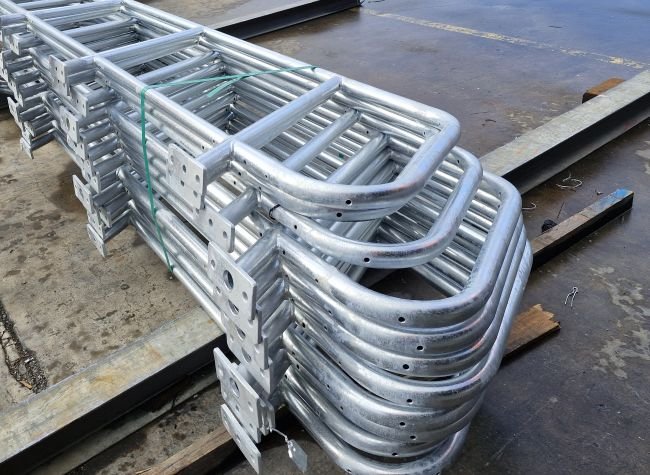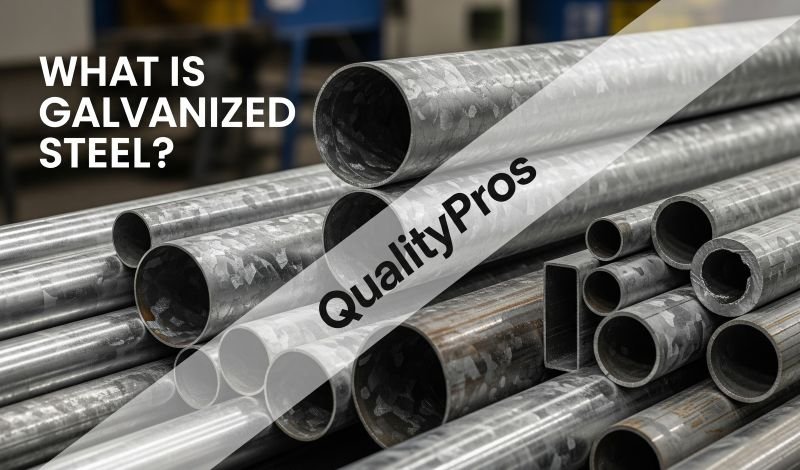Galvanized steel is steel coated with zinc to prevent rust and corrosion, making it highly durable for various applications. The zinc layer acts as a protective barrier and sacrifices itself to protect the steel, even if scratched. This process, called galvanization, is widely used in construction, automotive, and other industries. Research suggests galvanization significantly extends steel’s lifespan, though the effectiveness depends on the method used and environmental conditions. Below, we explore the types, uses, benefits, and chemical processes involved in galvanization.
What is Galvanized Steel?
Galvanized steel is created by applying a zinc coating to steel, typically through methods like hot-dip galvanizing or electro-galvanizing. This coating prevents moisture and oxygen from causing rust, ensuring the steel remains strong in harsh environments like rain or salty air.
Types of Galvanization
- Hot-Dip Galvanizing: Steel is dipped in molten zinc, forming a thick, durable coating with zinc-iron alloy layers.
- Electro-Galvanizing: Zinc is applied using an electric current, creating a thinner, smoother coating.
- Sherardizing: Steel is heated with zinc dust, forming a uniform zinc-iron alloy layer.
- Zinc Spraying: Molten zinc is sprayed onto steel, providing a protective zinc layer without alloy formation.
Common Uses
Galvanized steel is used in construction (e.g., roofing, fencing), automotive parts (e.g., car bodies), agriculture (e.g., farm equipment), infrastructure (e.g., bridges), and household items (e.g., appliances).
Key Benefits
- Corrosion Resistance: Zinc protects steel from rust, extending its life.
- Longevity: Can last 20–50 years without maintenance, depending on the environment.
- Cost-Effective: Lower long-term costs due to reduced maintenance.
- Recyclable: Both zinc and steel are fully recyclable, supporting sustainability.
In-Depth Guide to Galvanized Steel: Types, Uses, Benefits, and Chemical Processes
Galvanized steel, a cornerstone of modern engineering, is steel coated with zinc to prevent corrosion, enhancing its durability across diverse applications. The galvanization process creates a protective zinc layer that shields the steel from environmental factors like moisture and oxygen, which cause rust. This blog post provides a comprehensive exploration of galvanized steel, delving into its types, applications, benefits, and the intricate chemical processes and reactions involved. Whether you’re a homeowner, engineer, or industry professional, understanding galvanized steel’s properties and processes will highlight its value in creating long-lasting, reliable products.
Understanding Galvanized Steel
Galvanized steel is produced by applying a zinc coating to steel, typically through methods like hot-dip galvanizing, electro-galvanizing, sherardizing, or zinc spraying. The zinc acts as a barrier and a sacrificial anode, corroding before the steel if the coating is damaged. This dual protection mechanism makes galvanized steel ideal for environments prone to corrosion, such as coastal areas or industrial settings. According to the American Galvanizers Association, galvanized steel can last up to 50 years in rural environments and 20–25 years in harsher urban or coastal conditions, showcasing its robustness.
Types of Galvanization Processes
Galvanization encompasses several methods, each with distinct processes, chemical reactions, and applications. Below is a detailed look at the primary types:
1. Hot-Dip Galvanizing
- Process Overview:
- Surface Preparation: Steel is cleaned through degreasing (to remove oils), pickling (using hydrochloric or sulfuric acid to remove scale), and fluxing (with zinc ammonium chloride to prevent oxidation).
- Immersion: The steel is submerged in a bath of molten zinc at 445–465°C (833–869°F) for a few minutes, depending on the steel’s size and thickness.
- Cooling: The steel is withdrawn and cooled, often in a passivation solution to prevent early oxidation, or in open air.
- Chemical Reactions:
- During immersion, a diffusion process occurs where zinc atoms penetrate the steel surface, and iron atoms diffuse into the zinc, forming zinc-iron intermetallic layers. These layers include:
- Gamma (Γ) Layer: Fe₃Zn₁₀ (approximately 75% zinc, 25% iron), closest to the steel.
- Delta (δ) Layer: FeZn₇ (90% zinc, 10% iron), an intermediate layer.
- Zeta (ζ) Layer: FeZn₁₃ (94% zinc, 6% iron), zinc-rich.
- Eta (η) Layer: Pure zinc, the outermost layer.
- These layers form through a metallurgical reaction, not a simple chemical equation, as zinc and iron interdiffuse at high temperatures. The gamma, delta, and zeta layers are harder than the base steel, enhancing abrasion resistance, while the eta layer provides ductility.
- During immersion, a diffusion process occurs where zinc atoms penetrate the steel surface, and iron atoms diffuse into the zinc, forming zinc-iron intermetallic layers. These layers include:
- Applications: Used for outdoor structures like bridges, guardrails, roofing, and utility poles due to its thick, durable coating.
- Advantages: Offers robust corrosion protection and complete coverage, including internal surfaces of hollow structures.
2. Electro-Galvanizing
- Process Overview:
- Surface Preparation: Similar to hot-dip galvanizing, involving cleaning to ensure a smooth surface.
- Electroplating: The steel acts as the cathode in an electrolyte solution (e.g., zinc sulfate or cyanide). An electric current reduces zinc ions, depositing a thin zinc layer on the steel.
- Chemical Reactions:
- At the cathode (steel): Zn²⁺ + 2e⁻ → Zn
- At the anode (often zinc): Zn → Zn²⁺ + 2e⁻
- This electrochemical process results in a pure zinc coating without intermetallic layers, providing a smoother, thinner finish.
- Applications: Ideal for automotive parts, appliances, and electronics where a polished appearance is desired.
- Advantages: Produces a uniform, aesthetically pleasing coating suitable for painting or further processing.
3. Sherardizing
- Process Overview:
- Steel parts are placed in a sealed container with zinc dust and heated to 350–400°C (662–752°F). Zinc vaporizes and diffuses into the steel surface, forming a uniform coating.
- Chemical Reactions:
- Similar to hot-dip galvanizing, zinc diffuses into the steel, forming intermetallic compounds like FeZn₇ and FeZn₁₃. The exact composition depends on temperature and duration.
- Applications: Used for small, intricate parts like bolts, screws, and fittings where uniform coating is critical.
- Advantages: Provides consistent coverage on complex shapes without the need for immersion.
4. Zinc Spraying (Metallizing)
- Process Overview:
- Molten zinc is sprayed onto the steel surface using a spray gun, solidifying upon contact to form a protective layer.
- Chemical Reactions:
- No chemical reaction occurs; the process is purely physical, with zinc adhering to the steel surface.
- Applications: Suitable for large structures like bridges, pipelines, or field repairs where immersion is impractical.
- Advantages: Flexible application for oversized or irregularly shaped items, though it lacks the metallurgical bond of other methods.
| Galvanization Type | Process | Chemical Reaction | Key Applications |
|---|---|---|---|
| Hot-Dip Galvanizing | Immersion in molten zinc | Forms Fe₃Zn₁₀, FeZn₇, FeZn₁₃ layers | Bridges, roofing, guardrails |
| Electro-Galvanizing | Electrochemical deposition | Zn²⁺ + 2e⁻ → Zn | Automotive parts, appliances |
| Sherardizing | Diffusion with zinc dust | Forms FeZn₇, FeZn₁₃ layers | Bolts, screws, fittings |
| Zinc Spraying | Spraying molten zinc | No chemical reaction | Large structures, field repairs |
Applications of Galvanized Steel
Galvanized steel’s corrosion resistance and durability make it indispensable across multiple sectors:
- Construction: Used in roofing, siding, fencing, and structural components like beams and columns. Its ability to withstand weather makes it ideal for residential and commercial buildings.
- Automotive: Employed in car bodies, chassis, and undercarriage parts to resist corrosion from road salt and moisture. The National Material Company notes that 80% of a car’s body-in-white (unpainted frame) is galvanized steel.
- Agriculture: Found in farm equipment, storage tanks, silos, and livestock fencing, offering longevity in harsh outdoor conditions.
- Infrastructure: Critical for bridges, utility poles, street signs, and highway barriers, where minimal maintenance is essential.
- Household Items: Used in appliances (e.g., washing machines), hardware (e.g., nails, screws), and everyday items like buckets, ensuring durability.
Benefits of Galvanized Steel
Galvanized steel offers numerous advantages, making it a preferred material:
- Corrosion Resistance: The zinc coating acts as a barrier and sacrificial anode, protecting steel even if scratched. The Galvanizers Association explains that zinc’s electrochemical activity ensures it corrodes before steel.
- Longevity: Can last 50 years in rural settings and 20–25 years in urban or coastal areas without maintenance, per the American Galvanizers Association.
- Cost-Effectiveness: While initial costs are higher, the reduced need for repairs or replacements lowers life-cycle costs compared to painted steel.
- Recyclability: Both zinc and steel are 100% recyclable, aligning with sustainability goals.
- Aesthetic Flexibility: Can be painted or left with its natural spangled finish for a modern look.
- Abrasion Resistance: The zinc-iron alloy layers (gamma, delta, zeta) are harder than steel, providing protection against mechanical damage.
Chemical Processes and Reactions
The galvanization process involves complex chemical and metallurgical interactions, particularly in hot-dip galvanizing:
- Hot-Dip Galvanizing:
- Surface Preparation: Degreasing removes oils, pickling (e.g., hydrochloric acid) eliminates scale, and fluxing (zinc ammonium chloride) prevents oxidation.
- Immersion: At 445–465°C, zinc diffuses into the steel, forming intermetallic layers through a diffusion process. The layers (gamma: Fe₃Zn₁₀, delta: FeZn₇, zeta: FeZn₁₃, eta: pure zinc) create a robust, bonded coating.
- Cooling: The steel is cooled, often in a passivation solution to form a zinc carbonate patina (ZnCO₃), enhancing corrosion resistance.
- Electro-Galvanizing:
- Involves electrochemical reduction: Zn²⁺ + 2e⁻ → Zn at the steel cathode, depositing a pure zinc layer without intermetallics.
- Sherardizing:
- Zinc diffuses into the steel at 350–400°C, forming similar intermetallic compounds as hot-dip galvanizing.
- Zinc Spraying:
- A physical process with no chemical reaction, where zinc solidifies on the steel surface.
Historical Context
Galvanization was pioneered by French chemist Paul Jacques Malouin in 1742 and patented by Stanislas Sorel in 1836. Named after Luigi Galvani, who studied electrochemical processes, galvanization has evolved into a standard corrosion protection method, with hot-dip galvanizing being the most common since the 19th century.
Potential Drawbacks
- Initial Cost: Higher than untreated steel due to the galvanization process.
- Environmental Impact: Chemical use and energy consumption require responsible management, though recyclability mitigates this.
- Welding Challenges: Zinc fumes during welding necessitate safety precautions.
Conclusion
Galvanized steel is a vital material, offering unmatched corrosion resistance through various galvanization methods. The chemical processes, particularly the formation of zinc-iron intermetallic layers in hot-dip galvanizing, ensure a durable, long-lasting coating. Its applications span construction, automotive, agriculture, infrastructure, and household goods, driven by benefits like longevity, cost-effectiveness, and recyclability. As industries prioritize sustainability and durability, galvanized steel’s role will continue to grow, supported by centuries of proven performance.
Key Citations
- Galvanization Overview – Wikipedia
- Hot-Dip Galvanizing Process – Wikipedia
- Galvanised Coating Structure – Galvanizers Association UK
- Hot-Dip Galvanizing Coating Details – American Galvanizers
- Iron-Zinc Intermetallics in Galvanneal – SpringerLink
- Intermetallics in Hot Dip Galvanizing – ResearchGate
- Intermetallic Phases in Galvanizing – ResearchGate
- Galvanized Iron and Steel Characteristics – GSA
- Zinc Processing and Galvanizing – Britannica

